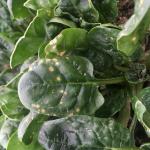Spinach, Cladosporium Leaf Spot
Identification
Cladosporium leaf spot is caused by the fungal pathogen Cladosporium variabile. Early leaf spots are tan colored, and expand to 1-3mm in diameter. Adjacent spots may coalesce, forming irregular lesions. As the disease develops, velvety dark green-brown sporulation develops within the lesions. In severe cases, older infected leaves may be killed.
Life Cycle
Development of Cladosporium leaf spot is favored by cool, humid environmental conditions that often occur in the fall and in winter high tunnels in New England. Optimum conditions for infection are 59-68°F and relative humidity above 80%, but infection can occur at temperatures between 50 and 86°C and the fungus can continue growing at temperatures as low as 41°F.
In the absence of a spinach crop, Cladosporium may overwinter on crop residue, spinach volunteers, and weed hosts (which weeds serve as hosts for this diseases has not been confirmed). Viable spores of Cladosporium have been isolated from dried spinach leaves and seed up to 8 years old. In the field, spores are spread by splashing water, wind, workers, and equipment.
Cladosporium can be seed-borne; in one 2006 study from Washington State University, Cladosporium was found infesting 37 out of 66 seed lots tested, with infestation levels ranging from 0-49%. Under the right environmental conditions, it’s likely that seed contamination could lead to infected seedlings, although this hasn’t yet been confirmed in the field, only in a controlled greenhouse environment.
Cultural Controls & Prevention
- Till under crop residues promptly after harvest to speed up decomposition.
- Hot water seed treatment can effectively eliminate Cladosporium from spinach seed. Researchers at Washington State University found that treating infested seed at 40°C/104°F for 10 minutes sufficiently eliminated Cladosporium and that germination only decreased when seed was treated at 50°C/122°F for 30 minutes or more, or at 55°C/131°F for 10 minutes or more. Click here to learn about the UMass Vegetable Program Hot Water Seed Treatment Service.
- Chlorine seed treatment also effectively eliminates Cladosporium from spinach seed and does not reduce germination. Soak seed for 10 minutes in a 1.2% sodium hypochlorite (NaOCl) solution. NaOCl is the active ingredient in bleach; different bleach products have different percentages of NaOCl, with 5.25% being a common concentration. To make a 1.2% NaOCl solution from a common 5.25% NaOCl product, dilute bleach with water at a 1:3 ratio. There are many bleach solution calculators available online (here’s an example). Note for dilution calcuators: 1000ppm = 1%. Chlorine seed treatment may be allowed for certified organic growers if the seed is rinsed immediately after treatment; contact your certifier for approval before beginning this or any other chemical material practice.
- Use drip irrigation or overhead irrigate early in the day on sunny days, when possible, so that crop foliage will dry quickly.
- Control weeds within your crop, as well as around the outside edge of high tunnels, both to increase air flow and eliminate possible weed hosts.
- Variation in susceptibility to Cladosporium between spinach varieties has been noted in the field, but resistance is not regularly evaluated for commercially available varieties.
Chemical Controls
Few products are labeled specifically for Cladosporium leaf spot in spinach and little research has been conducted on chemical control of this disease. QoI fungicides, commonly known as strobilurins, (FRAC Group 11) have been shown to effectively control this disease. Group 11 products that are labeled for spinach include Quadris (note: Quadris Top and Opti are not labelled for use on spinach), Reason, and Cabrio, and combination products including Merivon (groups 7 & 11) and Tanos (groups 27 & 11). In one University of Florida trial that evaluated Cabrio, Merivon, and Tanos, among other products, Cabrio and Merivon provided better control than Tanos.
Because QoI fungicides have a single-site mode of action, pathogens frequently develop resistance to this group of fungicides. A few rules of thumb for using materials in FRAC group 11 are:
- Limit the total number of QoI applications. Product labels often provide information on maximum number of applications allowed per season. If no guidelines are given, make no more than 3 applications.
- Use a maximum of 1 QoI spray out of every 3 fungicide applications when using QoI alone (as opposed to a tank mix or combination product).
- Use a maximum of 1 QoI spray out of every 2 fungicide applications when using a tank mix or combination product.
- Do not make consecutive applications of QoI fungicides.
- Tank mix with a contact fungicide or use a combination product containing a contact fungicide (e.g. chlorothalonil, mancozeb, sulfur, oil).
Copper products are effective protectants for this disease.
No research has been conducted on control of Cladosporium with OMRI-listed products. Copper is the most effective OMRI-listed material for controlling foliar fungal diseases, in general. Adding a Bacillus subtilis (e.g. Serenade) or Bacillus amyloliquefaciens (e.g. Double Nickel, Stargus, Taegro, Triathlon) product to copper has a synergistic effect, meaning that applying copper + Bacillus provides better control than either product alone. Hydrogen dioxide products (e.g. OxiDate) will kill spores on contact but does not kill the fungus within the plant or offer any protection against future infections.
Crops that are affected by this disease:
- Spinach
Sources:
- Cladosporium Leaf Spot on Spinach Seed Crops and Control Measures. Debra Ann Inglis, Mike Derie, and Richard Gabrielson, Washington State University.
- Hernandez-Perez, P. and du Toit L. J. 2006. Seedborne Cladosporium variabile and Stemphylium botryosum in Spinach. Plant Disease 90:2.
- Du Toit, L. J. and Hernandez-Perez, P. 2005. Efficacy of hot water and chlorine for eradication of Cladosporium variabile, Stemphylium botryosum, and Verticillium dahliae from spinach seed. Plant Disease 89:12.
 This material is based upon work supported by the National Institute of Food and Agriculture, U.S. Department of Agriculture, through the Northeast Sustainable Agriculture Research and Education program under subaward number LNE20-402.
This material is based upon work supported by the National Institute of Food and Agriculture, U.S. Department of Agriculture, through the Northeast Sustainable Agriculture Research and Education program under subaward number LNE20-402.
The Center for Agriculture, Food and the Environment and UMass Extension are equal opportunity providers and employers, United States Department of Agriculture cooperating. Contact your local Extension office for information on disability accommodations. Contact the State Center Director’s Office if you have concerns related to discrimination, 413-545-4800 or see ag.umass.edu/civil-rights-information.

